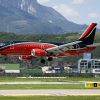 As an essential revenue generating asset, an aircraft generates value when it’s airborne and operating at close to peak capacity. Meanwhile, an aircraft that is idle for any reason (malfunction, maintenance, flight cancellation, etc.) simply bleeds money. According to a rather conservative estimate by Boeing, a 1–2-hour aircraft on ground event might cost an airline $10-20,000. Those in the industry will tell you that the actual cost is more in the region of $150,000, if not more. Yet, while most AOG events are hard to predict, airlines and air operators, especially those focusing on travel in Europe, know that there’s one thing worse than an unexpected incapacity to fly. That’s the seasonal nature of the business, with capacity linked tightly to the travel patterns of travellers and holidaymakers.
As an essential revenue generating asset, an aircraft generates value when it’s airborne and operating at close to peak capacity. Meanwhile, an aircraft that is idle for any reason (malfunction, maintenance, flight cancellation, etc.) simply bleeds money. According to a rather conservative estimate by Boeing, a 1–2-hour aircraft on ground event might cost an airline $10-20,000. Those in the industry will tell you that the actual cost is more in the region of $150,000, if not more. Yet, while most AOG events are hard to predict, airlines and air operators, especially those focusing on travel in Europe, know that there’s one thing worse than an unexpected incapacity to fly. That’s the seasonal nature of the business, with capacity linked tightly to the travel patterns of travellers and holidaymakers.
Seasonality remains a factor even post-recovery
Before the COVID-19 pandemic, a discernible trend emerged in the global travel industry: leisure travel has begun outpacing business travel in many countries and regions. From 2010 to 2019, the compound annual growth rate for leisure air trips stood at 6.6%, substantially higher than the 3.3% rate for business air trips, according to McKinsey & Company. This disparity in growth rates has only broadened in certain areas during the post-pandemic recovery phase of air travel. As the industry continues to rebound from the 2020 downturn, the resurgence in leisure traffic has assumed the fastest pace. The problem with leisure travel, however, is the fact that it is more seasonally driven, with marked peaks and troughs aligning with the Northern Hemisphere’s summer and winter months.
According to recent data from IATA, in 2023, European carriers’ traffic saw a 22% year-on-year increase. While the trend is positive, with a parallel increase in capacity and load factor, the recovery is slower than in other regions. Recovery of specifically winter season travel in Europe might be even slower due to the tightening of purse strings for many Europeans. With the European Central Bank reluctant to lower record-high interest rates, we can expect Europeans to be more cost sensitive when planning their holidays, even though some airline executives might believe that consumer spending on travel is immune to the cost of living crisis. Time will tell.
It is worth noting that even if the recovery is speedier than expected, seasonality in Europe is not going away. We have all seen reports of major European airlines posting substantial profits in 2023 Q3, with some performing better than in 2019. But what happens when more than 50% of your annual operating profits come from a single quarter? This disproportion is problematic for several reasons. For one, the uptick in demand during the summer can lead to delayed flights, overstretched staff and unhappy customers. Still, those symptoms don’t put companies in financial jeopardy. Something that can’t be said when it comes to the accumulation of additional aircraft and staff. Acquiring capital-intensive aircraft and having them fly at half-capacity or sit idle during the low season naturally leads to losses.
Better planning is key but is not a silver bullet
To stay profitable, airlines must implement strategic measures to effectively manage summer demand peaks, ensure stable operations, and crucially, mitigate or reverse winter losses. Counteracting the impact of seasonality requires several critical approaches that airlines should consider adopting.
This begins with being more rigorous when it comes to planning for the entire year. Key strategies to keep in mind involve optimizing yields through established pricing and revenue management techniques. Here, we are already seeing a surge in Artificial Intelligence solutions and the role of AI will only increase in the nearest future.
An airline’s plan for the year should account for more than just summer-winter fluctuations. Having commercial agreements with tour operators, government agencies and other clients in need of air transport during massive events (from the Hajj to the Olympics) is a key factor.
In addition to being better planners, airlines should also look for potential surges in demand linked to specific events. For example, after hosting the World Cup in 2022, Qatar became the destination of choice for Gulf travellers in 2023. Thanks to a flurry of high-profile events and an elevated profile, Qatar broke the 4 million tourist barrier for the first time. Unsurprisingly, 85% of all visitors arrived by air, according to the country’s Civil Aviation Authority.
Combatting seasonality – an ACMI perspective
Outsourced capacity providers are increasingly integral to the operational strategy of individual airlines. Having a leaner internal fleet helps a company to absorb seasonal decreases in demand for airlines. It is telling that in 2023 almost 738,000 block hours (BH) were operated by ACMI companies around the world, according to ACC Aviation. This number shows an almost 100% year-on-year increase, and with pandemic-related restrictions behind us, we can expect more airlines to incorporate outsourced capacity into their strategy.
Having on-demand aircraft is beneficial during upticks in demand. For example, Avion Express, one of Avia Solution Group’s ACMI providers, delivered over 2000 flights for Germany’s Eurowings this June, when the airline needed that additional capacity most.
However, it is important to understand that ACMI providers are subject to the same seasonal dynamics as other airlines. If an ACMI provider can only properly supply demand in one region during one season, it has rather limited growth potential, even with a wide network of clients.
With ACMI leasing, airlines and other clients (including governments) can outsource not only the aircraft but also the crew and associated ownership responsibilities. This is also forcing ACMI providers to think differently, as it forces us to approach seasonality as a long term strategy element rather than a short term challenge. And this requires a rethinking of the ACMI model itself, a model that is global by design.
Geographical expansion is one way of mitigating seasonality. Having secured AOCs across several continents means that aircraft and other assets can be moved around the globe with less hassle. If you have major operations in Europe, it is valuable to set up outposts in regions like South-East Asia and Australia, where travel demand spikes and lulls don’t overlap that much with Europe. This allows one to counterbalance the reduced seasonal demand in Europe during the winter by shifting aircraft to these regions.
At Avia Solutions Group, we have started strategically investing in Asia-Pacific and Latin America several years ago. Today, we have 11 AOCs and we are intending to grow their number, with a strong focus on the mentioned regions. By the end of 2024, the group aims to establish or acquire additional airlines in several countries, including Brazil, Thailand, the Philippines, Malaysia, Australia, Indonesia. In parallel, we are developing our MRO network with recently added hangars in Bali and Punta Cana.
By spreading their wings and adapting a global mindset, ACMIs are also taking on the risks that airlines can do without. It’s essential to acknowledge that while wet leasing may appear costly initially, airlines must consider the significant value loss incurred by maintaining idle owned aircraft during low-demand periods like winter. Any outsourcing decision must be underpinned by a balance of cost efficiency, service reliability, and superior passenger experience to ensure its viability and success.





